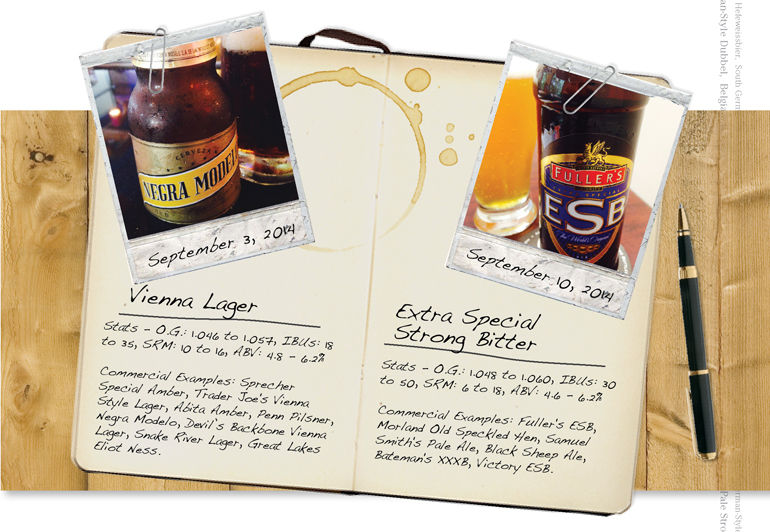Start 14-Day Trial Subscription
*No credit card required

Vienna Lager and Extra Special Strong Bitter / ESB
For our Fall Issue, Owen Ogletree provides the telling details behind two well traveled beers that may move around but have never gone out of style.
It was Owen, himself an intrepid voyager, who once observed you had to go to Mexico or Cleveland to get a classic Vienna Lager. But that’s no longer the case. In a revival that is notable for an emphasis on balance, moderation and taste, quite a few American craft brewers have chosen to include a Viennese lager in their portfolios.
Should you find yourself in a Mexican restaurant with no American craft in sight, check out the Negra Modelo for a taste of Vienna – and some Napoleonic history – that pairs well with enchiladas.
If a taste of London is what you’re looking for, it’s a bit easier to tap the source. Extra Special Strong Bitter, or ESB, is readily available as an import from London as well as from American craft brewers. It’s the balance of malt, hops and alcohol in this so-called bitter that make it a classic.
Vienna Lager
The story of Vienna Lager began in 1841 when brewer Anton Dreher of the Schwechat Brewery in Austria used his kilns to lightly roast a new type of pale malt that produced beers with a pale color, light notes of toast and a soft, elegant, sophisticated flavor profile. Dreher’s malt took on the name Vienna malt, and the novel brew followed suit with the moniker Vienna Lager.
Jump to France in 1864 -- Napoleon III declared Maximilian I, an Austrian Habsburg, emperor of Mexico. Maximilian moved to Mexico and took along quite a collection of Austrian brewers, each of which brought a love for this lager from Vienna. After only three years, Mexico’s Benito Juarez led a revolution that overthrew the European leaders and executed Maximilian. For obvious reasons, the Austrian brewers had become valued members of the community and were allowed to continue production of their lager and shape the future of the beer industry in Mexico.
Although Schwechat was the largest brewer in the world at the turn of the 20th Century, the pilsner styles soon gained enormous popularity in Europe and Vienna Lager fell out of favor in Austria and the rest of the continent. These days, searching Vienna for a true Viennese-style lager will lead to serious frustration on the part of any uninformed craft beer aficionado. To taste current interpretations of the style, one must now look mainly to Mexico or to numerous American craft breweries and brewpubs. As they have done with many rare, historic beer varieties, American brewers researched the Vienna Lager style and helped resurrect the beer here at home.
A classic Vienna Lager displays colors of ruddy amber/copper to an almost ruby-hued brown. This is a polished, cold-conditioned lager that should be quite clear with no chill haze or sediment. The beer should be topped by a substantial, off-white layer of foam with impressive head retention.
Schwechat was the largest brewer in the world at the turn of the 20th Century. But the pilsner styles soon gained enormous popularity and Vienna Lager fell out of favor in Austria and the rest of the continent.
Compared to a classic Oktoberfes/Märzen, a Vienna Lager should waft moderate, more restrained aromas of complex, Vienna and/or Munich malts -- with an appealing toasted malt note often backed by just a hint of biscuits. Low noble hop presence comes through as a trace on the nose, and fruity esters and butterscotch-like diacetyl should be absent completely. Brewers also try to avoid sweet caramel aroma and flavor in the style.
Along with light malt sweetness in the flavor profile, a classic Vienna-style lager contains a toasted, melanoidin-focused, Vienna malt character and just enough floral, noble-type hop bitterness to provide a crisp, somewhat dry, well-balanced finish. Hop flavor and bitterness can be low to moderately low. Caramel and dark malts may be used to add color and body, but caramel malts shouldn’t contribute to aroma and flavor, and roasted malt notes from dark malts are usually avoided.
Lager yeast, which was isolated around the same time that Vienna malt was first produced in the 1800s, thrives in cold temperatures and ideally produces beers with no perceptible fruity esters that are common with lively ale yeast strains employed at warmer temperatures. Vienna-style lagers definitely should exhibit this clean lager profile -- with corn-like DMS, butterscotchy diacetyl and spicy phenol compounds always absent.
When swirled around the palate, a well-made Vienna Lager should impart a medium-light to medium mouthfeel with a soft, pleasant, creamy sensation that comes across as not sweet or too toffee-like when swallowed. Carbonation should be moderate and on par with a typical Oktoberfest, Munich-style dunkel or helles lager.
Pairing food items with this versatile lager style is not challenging. Of course, Mexican dishes like enchiladas, fajitas, chili rellenos and even red menudo are a no-brainer with a Vienna-style lager. The crisp, toasty character of the beer also make a lovely complement alongside pizza, fried fish, sausage, roast pork, grilled vegetables, smoked trout, caramel flan and jalapeño jack cheese.
Exquisite Vienna and German-type lager malts form the framework of this classic style that’s so often overlooked and taken for granted by lovers of modern, extreme craft beers. Vienna-style lagers take time, effort and concentration to appreciate, but their enduring presence in our 21st Century beer culture is verification of their elegant allure.
Statistics:
O.G.: 1.046 to 1.057,
IBUs: 18 to 35
SRM: 10 to 16
ABV: 4.8 - 6.2%
Commercial Examples: Sprecher Special Amber, Trader Joe's Vienna Style Lager, Abita Amber, Penn Pilsner, Negra Modelo, Devil’s Backbone Vienna Lager, Snake River Lager, Great Lakes Eliot Ness.



